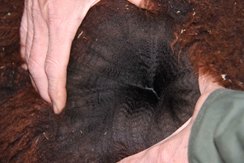|
Wednesday, October 23, 2013

Hanblecheyapi "buttery" Fleece.
We attended the Michigan Alpaca Festival in Grand Rapids Michigan October, 2013. The judge’s recitations included “finest in the class but lacks the density…”, “best fleece in the class but would like to see a larger frame – but they are young and have growing to do”, but always “extremely nice hand.”. We hear “extremely nice hand” in recitations consistently from one judge to the next.
In part “hand” is a result of uniformity measured by Standard Deviation in Watt (OFDA2000) or Yocom (OFDA100) histograms. Standard Deviation alone can be deceptive being a measurement from the mean of the AFD and if that AFD is 14-micron or 30-micron it will not matter stating only how closely related the population of fibers tested are to each other.
We need to differentiate uniformity as measured by SD from consistency. Uniformity compares individual fiber-to-fiber and consistency recognizes the variation of the overall fleece from head to tail to toes. Consistency is assessed opening the fleece at various points observing variation from blanket to the bib and legs.
So uniformity may help the “hand” but is a small part of the story, after all a 30-micron fleece that has an SD of 3.0 or a 14-micron fleece that has an SD of 8.0 does not have “nice hand”. Both these feel good in general but fail the “buttery” adjective often applied to fleece with a “nice hand”.
Nice hand is a combination of four characteristics; fineness, uniformity, scale, and the closeness of primary to the secondary fiber diameter. One measurement that lends insight to how close the fibers are is Percent Over 30 on a histogram. Generally, primaries will be stronger and increase this percent however over time secondary fibers can contribute to this measurement. A magnifying glass assists differentiating primary from secondary fibers. Primary fibers in some alpacas stand out clearly. Alpacas with close diameters between primary and secondary fibers are difficult separating and are endemic to “nice hand”.
Scale on fiber can contribute to “nice hand”. Scale can be observed under a microscope and is not something we have done the reason is that there is no measurement nor base of information to compare what we see. So we will let our hand do the selection and histograms to compare.

Wasake contributes hand, consitency, fineness, density.
|